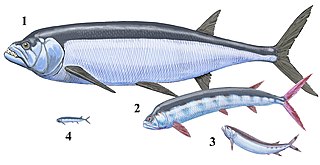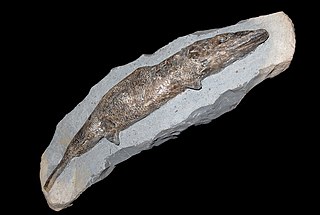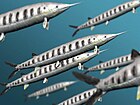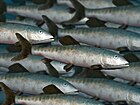
The Jurassic is a geologic period and stratigraphic system that spanned from the end of the Triassic Period 201.4 million years ago (Mya) to the beginning of the Cretaceous Period, approximately 145 Mya. The Jurassic constitutes the middle period of the Mesozoic Era as well as the eighth period of the Phanerozoic Eon and is named after the Jura Mountains, where limestone strata from the period were first identified.

The insect order Neuroptera, or net-winged insects, includes the lacewings, mantidflies, antlions, and their relatives. The order consists of some 6,000 species. Neuroptera is grouped together with the Megaloptera and Raphidioptera (snakeflies) in the unranked taxon Neuropterida.

Ichthyodectiformes is an extinct order of marine stem-teleost ray-finned fish. The order is named after the genus Ichthyodectes, established by Edward Drinker Cope in 1870. Ichthyodectiforms are usually considered to be some of the closest relatives of the teleost crown group.
Pleuropholis is an extinct genus of prehistoric ray-finned fish.

The Speeton Clay Formation (SpC) is a Lower Cretaceous geological formation in Yorkshire, northern England. Unlike the contemporaneous terrestrial Wealden Group to the south, the Speeton Clay was deposited in marine conditions. The most common fossils in the unit are belemnites, followed by ammonites and the lobster Meyeria ornata. Dinosaur remains are among the fossils that have been recovered from the formation, although none have yet been referred to a specific genus.

Crossognathiformes is an extinct order of ray-finned fish that lived from the Late Jurassic to the Eocene. Its phylogenetic placement is disputed; some authors have recovered it as part of the teleost stem group, while others place it in a basal position within crown group Teleostei. Other placements have found it to be paraphyletic, with the Varasichthyidae being stem-group teleosts whereas the other, "true" crossognathiforms are crown-group teleosts within the Teleocephala.
This list of fossil fishes described in 2016 is a list of new taxa of jawless vertebrates, placoderms, acanthodians, fossil cartilaginous fishes, bony fishes and other fishes of every kind that have been described during the year 2016, as well as other significant discoveries and events related to paleontology of fishes that occurred in the year 2016. The list only includes taxa at the level of genus or species.
This list of fossil fishes described in 2017 is a list of new taxa of jawless vertebrates, placoderms, acanthodians, fossil cartilaginous fishes, bony fishes and other fishes of every kind that are scheduled to be described during the year 2017, as well as other significant discoveries and events related to paleontology of fishes that are scheduled to occur in the year 2017. The list only includes taxa at the level of genus or species.
This list of fossil fish described in 2018 is a list of new taxa of jawless vertebrates, placoderms, acanthodians, fossil cartilaginous fish, bony fish, and other fish of every kind that are scheduled to be described during the year 2018, as well as other significant discoveries and events related to paleontology of fish that are scheduled to occur in 2018.
2018 in paleoentomology is a list of new fossil insect taxa that were described during the year 2018, as well as other significant discoveries and events related to paleoentomology that were scheduled to occur during the year.
This list of fossil fishes described in 2020 is a list of new taxa of jawless vertebrates, placoderms, acanthodians, fossil cartilaginous fishes, bony fishes, and other fishes of every kind that were described during the year 2020, as well as other significant discoveries and events related to paleoichthyology that occurred in 2020.
2015 in paleoentomology is a list of new fossil insect taxa that were described during the year 2015, as well as other significant discoveries and events related to paleoentomology that were scheduled to occur during the year.
This article records new taxa of fossil plants that are scheduled to be described during the year 2021, as well as other significant discoveries and events related to paleobotany that are scheduled to occur in the year 2021.
This list of fossil fish research presented in 2021 is a list of new taxa of jawless vertebrates, placoderms, acanthodians, fossil cartilaginous fishes, bony fishes, and other fishes that were described during the year, as well as other significant discoveries and events related to paleoichthyology that occurred in 2021.
This paleobotany list records new fossil plant taxa that were to be described during the year 2022, as well as notes other significant paleobotany discoveries and events which occurred during 2022.
This list of fossil fish research presented in 2022 is a list of new fossil taxa of jawless vertebrates, placoderms, cartilaginous fishes, bony fishes, and other fishes that were described during the year, as well as other significant discoveries and events related to paleoichthyology that occurred in 2022.
This paleobotany list records new fossil plant taxa that were to be described during the year 2023, as well as notes other significant paleobotany discoveries and events which occurred during 2023.
This list of 2023 in paleoentomology records new fossil insect taxa that are to be described during the year, as well as documents significant paleoentomology discoveries and events which occurred during that year.
This list of fossil fish research presented in 2023 is a list of new fossil taxa of jawless vertebrates, placoderms, cartilaginous fishes, bony fishes, and other fishes that were described during the year, as well as other significant discoveries and events related to paleoichthyology that occurred in 2023.












